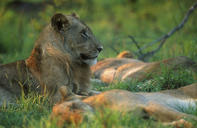A World of Diversity in One Park
The Addo Elephant National Park is a diverse wildlife conservation park situated about 50 km outside of Port Elizabeth in South Africa and is one of the country's 19 national parks. The history of Addo Elephant National Park is slightly shameful, but it has subsequently grown to become one of the foremost conservation areas in the country.
Addo Elephant National Park is an excellent place to end your journey along the South-Eastern seaboard of South Africa.

New Elephant Herds
Being the third largest national park in South Africa, means it has plenty of space to boast extensive and varied biodiversity, landscapes, wildlife and vegetation. Its tourist infrastructure is well-established and the scenery is pleasing. Many exciting environmental developments take place on a daily basis.
For example, fresh elephant breeding stock has been introduced to try and revive the declining gene pool of the native Addo elephants, which have become so inbred that female elephants are inexplicably born without tusks. These new elephant herds are slowly being introduced into the vast new tracts of land that have been incorporated into the park’s boundaries
South Africa's First 'Big Seven' Reserve

The dry, hot Addo bush comprises mainly of Karoo Boerboon trees (Schotia afra), small, pale-barked trees with fine feathered leaves and showy red flowers; the fleshy-leaved spekboom (Portulacaria afra) shrub with softwood much loved by sheep and browsing game - the leaves of which are also eaten by women who have insufficient milk for their babies - as well as the dense and twiggy common guarri bush (Euclea undulata).
The Addo Elephant National Park markets itself as South Africa’s first ‘Big Seven’ reserve (which includes elephants, lions, rhino, buffalo, leopards, great white sharks and whales). Buoyed by its proximity to the Garden Route, and its malaria-free location, Addo Elephant National Park has big plans to take on the supremacy of the Kruger Park in international travel itineraries.
Recently, lions were reintroduced to Addo Elephant National Park, after a 150-year absence from the region, and the World Wildlife Fund has granted the reserve $5 million to help buy up and rehabilitate adjoining farms. In the next few years, Addo plans to extend its boundaries all the way down to the sea, which will make it the second largest game reserve in the country.
History of Addo Elephant National Park

Once upon a time, the area that is now Addo Elephant National Park was all open bush; the last refuge of many wild animals, driven away from their traditional grazing lands by humans creeping up from the Cape.
When the Sundays River Valley was developed in the early 1900s, local farmers started nagging the government to get rid of the destructive elephantine nuisance that was getting in the way of their agricultural activities. In 1919, a professional hunter was called in, and he went on to kill 120 elephants in 12 months of concentrated slaughter. Only 15 elephants survived. The farmers were delighted, and encouraged the final extermination of the remaining elephants from the region.
By 1931 the hunt was called off and the Addo Elephant National Park was proclaimed. At that time only 11 elephants were left there, but they quickly multiplied, numbering 35 in 1964 and 120 by 1986. The Addo Elephant National Park protected not only the elephant, but also the last of the Cape's buffalo which had managed to escape persecution.
By David Fleminger There’s no better way to enjoy your Accommodation in Addo Elephant National Park than with a sundowner sitting on your stoep and watching,...
There’s no better way to enjoy your Accommodation in Addo Elephant National Park than with a sundowner sitting on your stoep and watching,... The Eastern Cape Coastal Route covers the length of the Eastern Cape Province stretching across a number of districts. The route starts at T...
The Eastern Cape Coastal Route covers the length of the Eastern Cape Province stretching across a number of districts. The route starts at T...